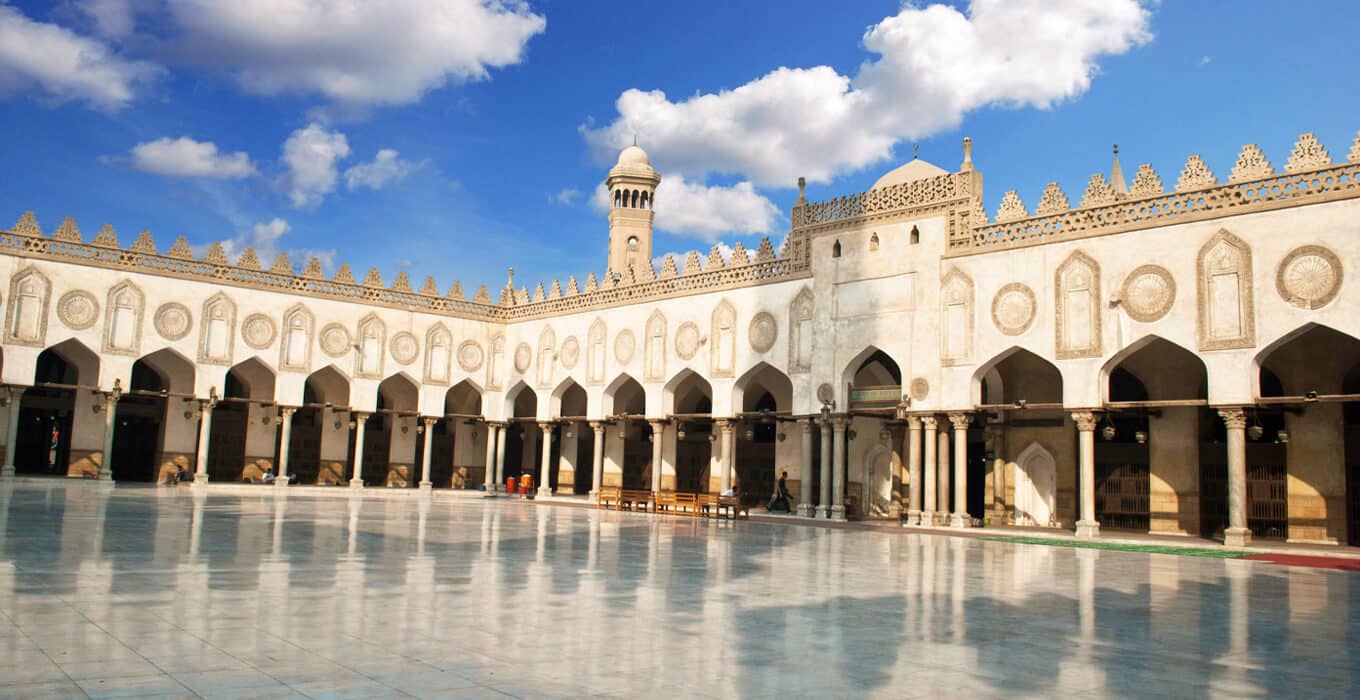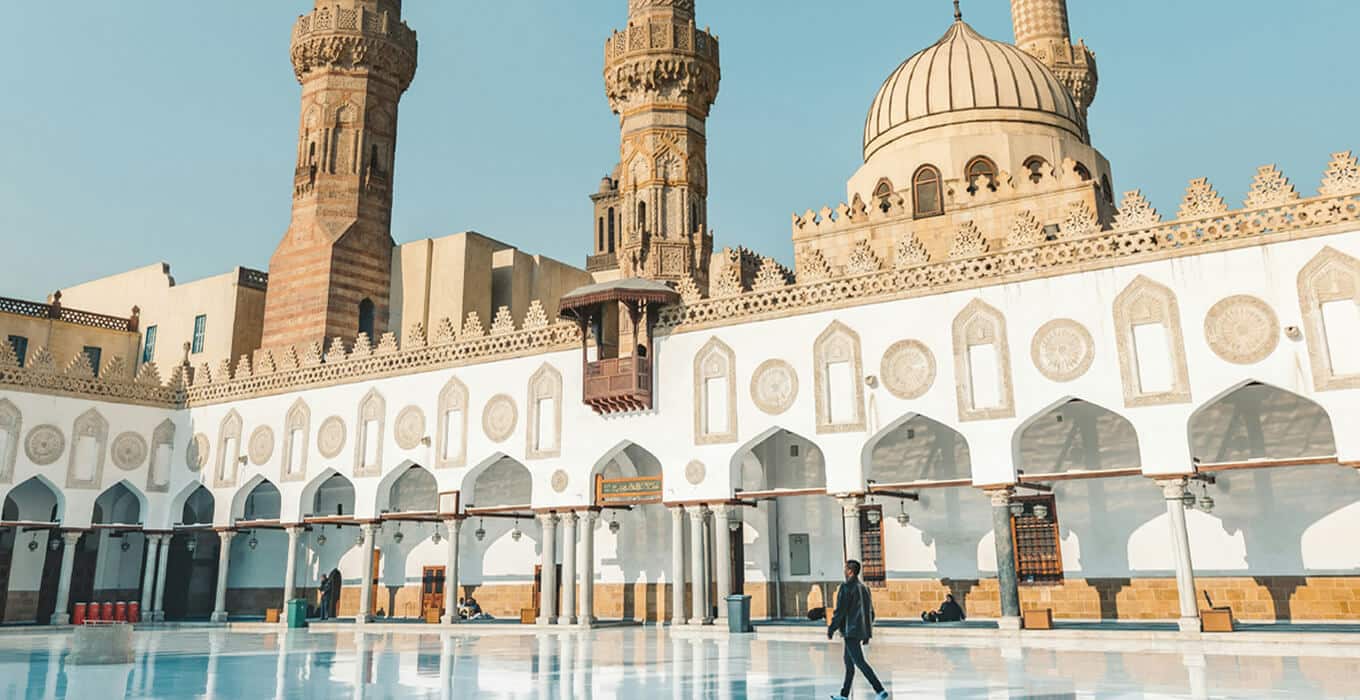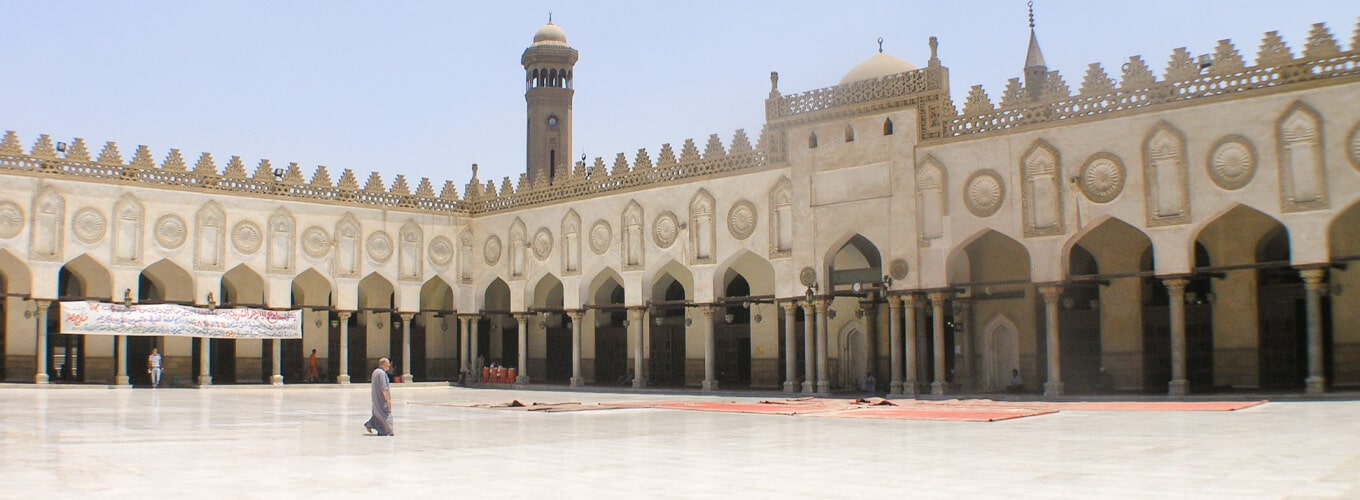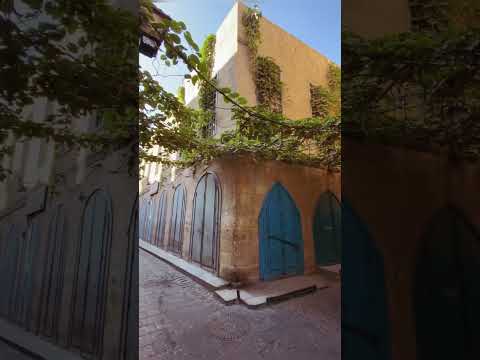Imagine stepping into a world where the past and present meet. The Al Azhar Mosque is a place where history and beauty come together. It’s a famous Islamic site in Cairo, Egypt, that has been important for over a thousand years.
But what makes this mosque special? And why is it a key symbol of Arab-Islamic culture?
Key Takeaways
- The Al Azhar Mosque is one of the oldest mosques in Egypt, established in 972 CE by the Fatimid Caliphate.
- It has served as a major center of Islamic scholarship and learning for over a millennium, housing the prestigious Al Azhar University.
- The mosque’s architectural splendor is a harmonious blend of various Islamic styles, reflecting the influence of different dynasties over its expansive history.
- The Al Azhar Mosque remains a deeply influential institution in Egyptian society and a symbol of the country’s rich Islamic heritage.
- Visitors can explore the mosque’s captivating interiors, learn about its storied past, and immerse themselves in the vibrant atmosphere, especially during the holy month of Ramadan.
Origins and Name
The Al-Azhar Mosque is a key Islamic site in Cairo, Egypt. It has a long history from the Fatimid Caliphate era. It was built in 969 CE by Jawhar al-Siqilli for the caliph al-Mu’izz.
At first, it was called al-Manṣūriyya, after the Fatimid caliphate in Tunisia. It started as a place for prayers in 972 CE. Later, al-Mu’izz changed the city’s name to al-Qāhira (Cairo).
It got its name, al-ʾAzhar, between al-Mu’izz’s time and the end of al-Aziz Billah’s rule. The name comes from az-Zahrāʾ, a name for Muhammad’s daughter Fatimah. She was the ancestor of the Fatimid dynasty.
Fatimid Caliphate and Al-Mansuriyya
The Fatimid Caliphate was a Shia Muslim dynasty that ruled from 909 to 1171 CE. They were key in the creation and early growth of the Al-Azhar Mosque. The mosque was ordered by Jawhar al-Siqilli in 969 CE, after Egypt was conquered by the Fatimids.
It was named al-Manṣūriyya, after the Fatimid caliphate’s old seat in Tunisia.
Theories on the Name “Al-Azhar”
The name “al-ʾAzhar” likely comes from az-Zahrāʾ, a name for Fatimah, the Prophet Muhammad’s daughter. The Fatimid dynasty claimed to be her descendants. This might be why they named the mosque after her.
But, some think it could also mean the mosque’s design or the greenery that once surrounded it.
Architectural Splendor
The Al-Azhar Mosque in Cairo, Egypt, is a stunning example of Fatimid architecture. It’s part of the larger Islamic architecture world. The main courtyard shows the mosque’s long history. The three minarets, from the 14th to 16th centuries, tell of its growth over time.
The mosque mixes different architectural styles from its many updates. Keel-shaped arches and carved stucco decoration add beauty. The big dome at the prayer hall’s entrance, from 1138, makes it a Mamluk architecture gem.
“Al-Azhar Mosque is a true testament to the enduring legacy of Islamic architecture and the remarkable craftsmanship of the Fatimid, Ayyubid, and Mamluk dynasties that have shaped its evolution over the centuries.”
This mosque is a key spot for those into Fatimid architecture, Islamic architecture, and mosque design. Its design and history are fascinating.
Fatimid Era: Foundation and Growth
Establishment as a Center of Learning
After its completion in 972 CE, the Al-Azhar Mosque became a key place for learning in the Islamic world. The Fatimid Caliphate made it a big center for learning. They shared the teachings of the Ismaili madh’hab with everyone, drawing scholars from all over.
In 988 CE, Yaqub ibn Killis made al-Azhar a main place for learning Islamic law. The next year, 45 scholars were hired to teach, starting what would become the top university in the Muslim world. The mosque got a big library with thousands of books, starting its huge collection.
The Fatimid era was a time of fast growth and change for al-Azhar. With the support of the Fatimid Caliphate, it became a top place for Ismaili Shia learning. Students and scholars came from all over the Fatimid Caliphate and beyond.
| Metric | Value |
| Capacity of Al-Azhar Mosque | 20,000 individuals |
| Site area of Al-Azhar Mosque | 15,600 m2 (168,000 sq ft) |
| Date established | 972 CE |
| Number of scholars hired in 989 | 35 |
| Total number of scholars hired in 988 | 45 |
“The Fatimid era witnessed the rapid growth and evolution of al-Azhar as a prestigious institution of Islamic education.”

Ayyubid Dynasty: Decline and Resurgence
When Saladin took over Egypt in 1171, the Ayyubid dynasty began. They ruled after the Fatimid Caliphate fell. Saladin, a strong Sunni Muslim, didn’t like the Shi’ite learning at al-Azhar Mosque under the Fatimids.
Under the Ayyubids, praying together at the mosque stopped. The library got worse, and Saladin took off the silver bands from the mihrab. These bands had the names of the Fatimid caliphs.
The Ayyubids wanted to push Sunni Islam by starting madrasas in Cairo. They stopped giving money to al-Azhar. This made al-Azhar teach less.
But, al-Azhar Mosque stayed important for learning in Arabic and Islam during the Ayyubid time. It showed it was still a key place in the Islamic world.
| Ayyubid Sultanate Key Facts | Values |
| Year of Establishment | 1171 |
| Maximum Territorial Coverage | 2,000,000 km² (770,000 sq mi) |
| Estimated Population (12th century) | 7,200,000 |
| Major Capitals | Cairo, Damascus, Aleppo, Hama |
| Common Languages | Arabic, Kurdish, Turkish |
| Number of Ayyubid Rulers | 8 |
| Duration of Ayyubid Rule in Egypt | 267 years |
Mamluk Sultanate: Renovations and Expansions
The Al-Azhar Mosque in Cairo changed a lot during the Mamluk Sultanate era. From the 13th to the 16th centuries, it got many new features and updates. This made it a key place for Islamic learning and prayer.
Architectural Additions and Refurbishments
Sultan Qansuh al-Ghuri built a special minaret in the early 1500s. It’s a tall, beautiful part of the mosque. The minarets of Qaytbay and Aqbugha were also added, making the mosque even more stunning.
The Mamluk leaders also fixed up the mosque a lot. They made the main dome look great around 1138. These changes made the mosque more beautiful and could hold more people.
| Key Mamluk Architectural Additions | Details |
| Double-finial Minaret of Qansuh al-Ghuri | Constructed in the early 16th century, this striking minaret became a defining feature of the mosque’s skyline. |
| Minaret of Qaytbay | An additional minaret added to the mosque’s architectural ensemble during the Mamluk era. |
| Minaret of Aqbugha | Another minaret constructed as part of the Mamluk-era renovations and expansions. |
| Central Dome above the Prayer Hall | This prominent architectural feature was crafted around 1138 CE under Caliph al-Hafiz as part of a major refurbishment project. |
These changes made the Al-Azhar Mosque a top place for Islamic learning and prayer. Scholars and worshippers came from all over to visit it.
Al Azhar Mosque Cairo Egypt: Significance and Influence
The Al-Azhar Mosque in Cairo, Egypt, has been a key place of Islamic scholarship for over a thousand years. It’s the top place in the Sunni Islamic world for learning theology and sharia (Islamic law). Many famous Islamic scholars have come from here.
The mosque is not just for religious learning. It has also been important for the intellectual and spiritual life of Muslims. It also helps shape Egyptian culture. Even when it faced hard times, the mosque stayed a respected place in Sunni Islam and showed Egypt’s deep Islamic roots.
The mosque is also known for its stunning architecture. It was built from 970 to 972 CE during the Fatimid Caliphate. It covers about 85 by 69 meters. Over time, it got new parts, like minarets and madrasas, during the Mamluk and Ottoman times.
| Architectural Features | Significance |
| Five Minarets | Each with a different design and height, representing the five pillars of Islam |
| Prayer Hall | Can accommodate up to 20,000 worshippers |
| Library | Holds approximately 100,000 copies, including old manuscripts |
The Al-Azhar Mosque’s lasting impact has shaped the Muslim world’s religious, intellectual, and cultural scene. It’s especially important in Sunni Islam and Egyptian culture. Its work as a Islamic scholarship center and its famous architecture keep it a key institution in the area.
Al-Azhar University: A Prestigious Institution
In the heart of Cairo, Egypt, lies the famous Al-Azhar University. It’s one of the oldest universities still open today. Founded in 970 CE, it has been a key place for Islamic education and Sunni theology for over a thousand years.
At first, it was a center for Ismaili Shia learning. But after the Fatimids fell, it became a top place for Sunni studies. Students from all over the Muslim world came, making it one of the oldest universities still around.
Now, Al-Azhar University offers many courses. You can study Islamic studies, Arabic literature, Egyptian history, and more. It has a huge library with over seven million pages of rare books. This makes it a key place for learning and research.
Through the years, Al-Azhar University has changed with the times. It has grown and changed to meet new needs. Its impact goes beyond the campus, shaping thought and faith in the Muslim world.
Visiting Al-Azhar Mosque
The Al-Azhar Mosque in Cairo, Egypt, is a key spot for those wanting to see Islamic heritage. It’s one of the oldest mosques still in use, from the 10th century. Visitors can come from sunrise to sunset without paying a fee.
Best Time to Visit
The best visit time is during Ramadan, the holy month. The mosque is busiest and most lively then. People from all over the world come to pray and celebrate, making it a memorable experience.
Dress Code and Etiquette
It’s key to dress modestly and with respect at the Al-Azhar Mosque. Men should wear loose, long pants and shirts that cover the chest and shoulders. Women should wear loose, long dresses or skirts that cover the arms, legs, and chest. Headscarves are a good idea but not needed. Remember, the mosque is sacred, so avoid loud talking, taking photos, and smoking.
By following these simple rules and exploring the mosque’s beauty and history, visitors can deeply understand and value this important Islamic site.

Legacy and Cultural Impact
The al-Azhar’s legacy is amazing. It’s a key part of Islamic Egypt. This mosque is one of the oldest and most respected in the area. It has been a center of Islamic learning for over a thousand years.
It’s known for its beauty and as a place of deep thought. The Al-Azhar Mosque shows Egypt’s deep cultural significance.
Even when it faced hard times, the mosque stayed important. It has brought up some of the most respected Islamic scholars. This has made it a key part of Islamic Egypt.
The mosque’s beauty shows the power of math in Islamic art. You’ll see amazing stucco work, marble verses from the Quran, and special Kufi calligraphy. These things show the mix of Arabian, Byzantine, Sassanian, and Central Asian art.
Through hard times, the Al-Azhar Mosque has always stood strong. It faced boycotts and neglect but kept going. It’s a symbol of Islamic art and architecture‘s lasting impact.
“The Al-Azhar Mosque has not only been a place of worship but also a bastion of Islamic learning, shaping the intellectual and spiritual landscape of the region for centuries.”
Modern-Day Al-Azhar
The modern Al-Azhar Mosque and its university are key in Egypt and Sunni Islam. They help with the intellectual and spiritual life. The university started as a school inside the mosque. It became a free university, Al-Azhar Al Sharif, in 1961 after the Egyptian Revolution of 1952. Now, it’s the top place to study Sunni theology, attracting students from everywhere.
The Al-Azhar Mosque is a big deal in Egyptian life. It’s a center for Islamic education and shows off the country’s rich religious and cultural past. It has a huge library with about 100,000 books, including old manuscripts before the mosque was built. This shows the area’s long effort to keep and share knowledge.
The mosque’s design shows a mix of styles from different times. It has Roman, Greek, and Byzantine touches, plus changes made over the years. This makes it a must-see for visitors and scholars. It gives a peek into the changing Islamic history of Egypt.
Conclusion
The Al-Azhar Mosque in Cairo, Egypt, is a key example of Islamic architecture and culture. It has been important for over a thousand years. Despite tough times, it’s now a key place in the Sunni Muslim world and a big part of Egypt’s culture.
It started as a center for learning during the Fatimid Caliphate. Now, it’s the heart of the Al-Azhar University. This mosque has greatly influenced the area’s knowledge and faith.
Visitors from all over the world are amazed by its beauty and history. The mosque shows the lasting impact of Islamic Egypt. It’s a symbol of strength, new ideas, and keeping Islamic knowledge alive.
As a UNESCO World Heritage Site, it’s a key place for moderate Islamic teachings. The mosque keeps up with today’s needs while honoring its past.
Read our related articles:

